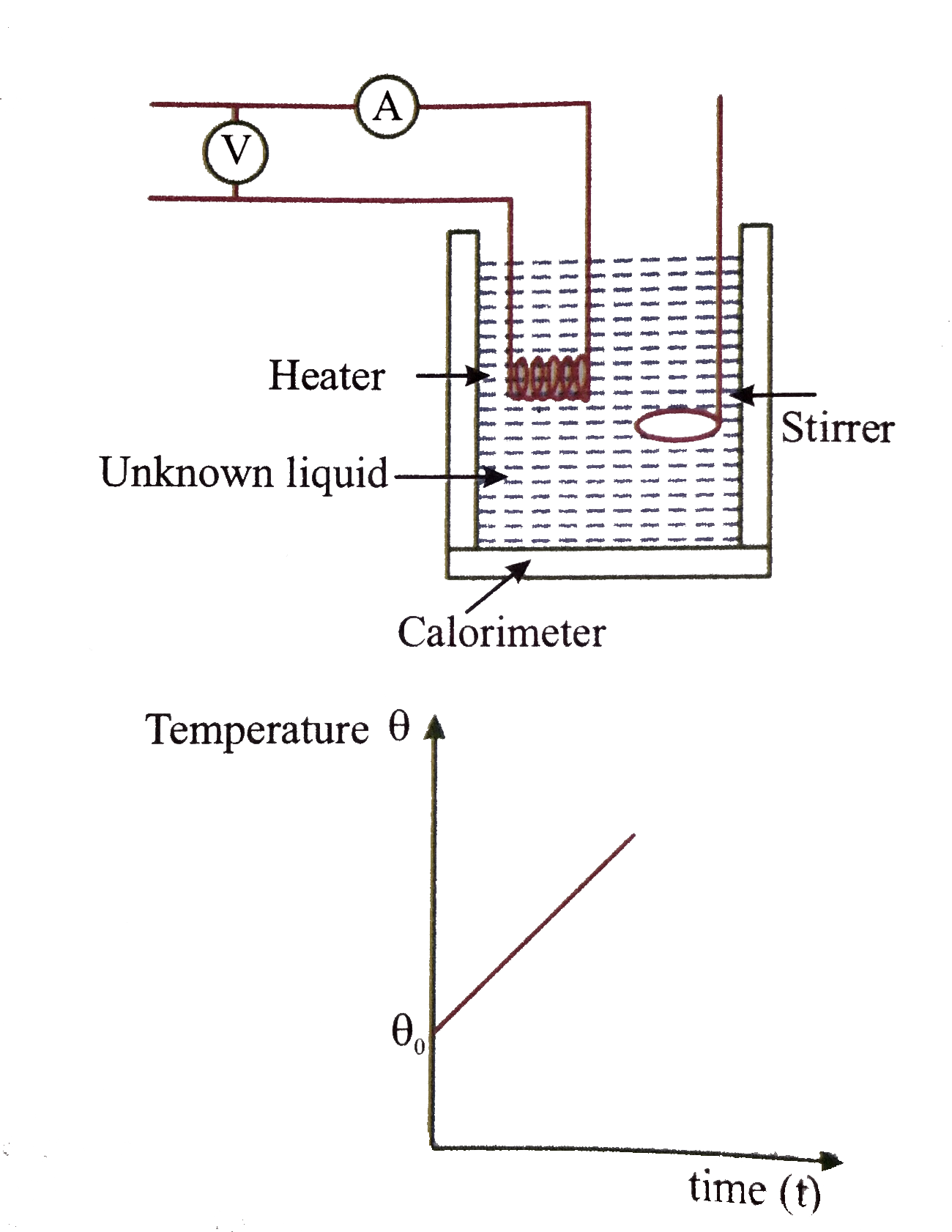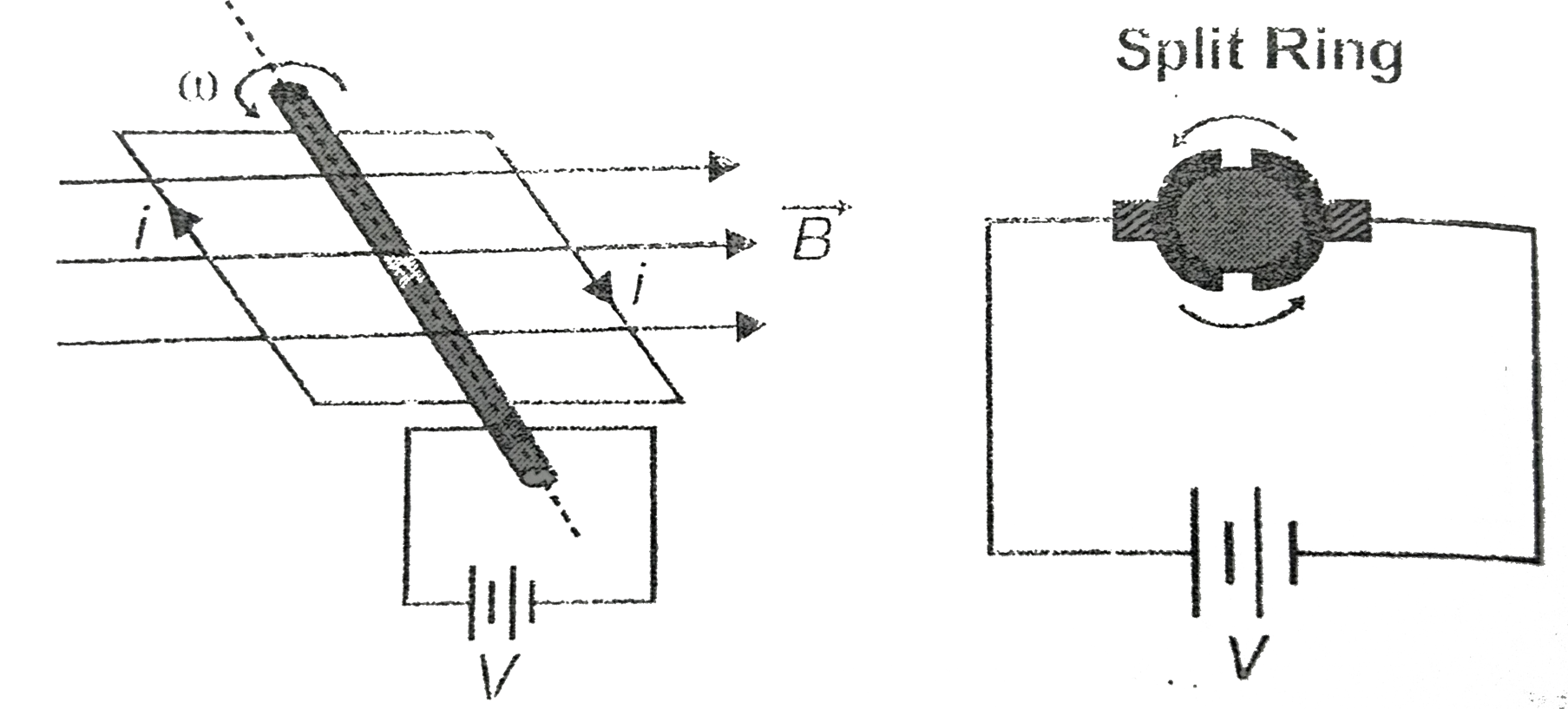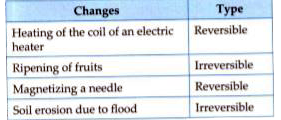Listed below are certain changes. Mention whether these are reversible or irreversible. Heating of the coil of an electric heater, ripening of fruits, magnetizing a needle, soil erosion due to flood.
Similar Questions
Knowledge Check
Figure shows an electrical calorimeter to determine specific heat capacity of an unknown liquid, First of all, the mass of empty calorimeter (a copper container) is measured and suppose it is m1. Then the unknown liquid is poured in it. Now the combined mass of calorimeter+liquid system is measured and let it be m2. So the mass of liquid is (m2−m1). Initially both were at room temperature (θ0).
Now a heater is immeresed in if for time interval t. The voltage drop across the heater is V and current passing through it is I. Due to heat supplied, the temperature of both the liquid and calorimeter will rise simultaneously. After tsec, heater was switched off, and final temperature is θr. If there is no heat loss to surroundings. Heat supplied by the heater=Heat absorbed by the liquid+heat absorbed by the calorimeter (VI)t=(m2−m1)S1(θf−θ0)+m1Sc(θf−θ0)
The specific heat of the liquid S1=(VI)tθf−θ0−m1Sc(m2−m1)

Radiation correction: There can be heat loss to environment. To compensate this loss, a correction is introduced.
Let the heater was on for tsec, and then it is switched off. Now the temperature of the mixture falls due to heat loss to environment. The temperature of the mixture is measured t/2sec. after switching off. Let the fall in temperature during this time is ɛ
Now the corrected final temperature is taken as θf=θf+ɛ
If mass and specific heat capacity of calorimeter is negligible, what would be maximum permissible error in Sl. Use the date mentioned below.
m1→, Sl→0, m2=1.00kg,
V=10.0V, I=10.0A,
t=1.00×102sec, θ0=15∘C,
Corrected θ1=65∘CA4%B5%C8%D12%The alternate discs of iron and carbon, having same area of cross-section are cemented together to make a cylinder whose temperature coefficient of resistivity is zero. The change in temperature in two alternate discs is same. The ratio of their thickness and ratio of heat produced in them is found out. The resistivity of iron and carbon at 20∘C are 1×10−7and3×10−5Ωm and their temperature coefficient of resistance are 5×10−3∘Cand−7.5×10−4∘C, respectively, Thermal expansion is neglected. Here, △R1+△R2=0 (where △R1,and△R2, are the increase in resistances of iron and carbon, respectively, with the rise in temperature) because combined temperature coefficient of resistivity is given as zero.
A copper wire is stretched to make it 1% longer. The percentage change in its resistance is Electrical resistance of certain materials, known as super conductors changes abruptly from a non zero value to zero as their temperture is lowered below a critical temperature Tc(0) An interesting property of superconductors is that their critical temperature becomes smaller than Tc(0) if they are placed in a magnetic field, that is, the critical temperature Tc(B) is a function of the magnetic field strength B. The dependence of Tc(P) on magnetic field is shown in the below figure.A0.002B0.01C0.015D0.025When an atom or an ion is missing from its normal lattice site, a lattice vacancy (Schottky defect) is created. In stoichimetric ionic crystals, a vacancy of one ion has to be accompanied by the vacancy of the oppositely charged ion in order to maintain electrical neutrality.
In a Frenkel defect an ion leaves its position in the lattice and occupies an interstitial void. This is the Frenkel defect commonly found along with the Schottky defects and interstitials. In pure alkali halides, Frenkel defects are not found since the ions cannot get into the interstitial sites. Frenkel defects are found in silver halides because of the small size of the Ag+ion. Unlike Schottky defects, Frenkel defects do not change the denstiy of the solids. In certain ionic solids (e.q. AgBr) both Schottky and Frenkel defects occur.
The defects discussed above do not disturb the stoichiometry of the crystalline material. There is large variety of non-stoichiomertic inorganic solids which contain an excess or deficiency of one of the elements. Such solids showing deviations from the ideal stoichiometric composition from an inmportant group of solids. For example in the vanadium oxide, VOx, x can be anywhere between 0.6 and 1.3. There are solids which are difficult to prepare in the stoichiometric composition. Thus, the ideal composition in compounds such as FeO is difficult to obtain (normally we get a composition of Fe0.95O but it may range from Fe0.93O to Fe0.96O). Non-stoichiometric behaviour is most commonly found for transition metal compounds though is also known for some lanthanoids and actinoids.
Zinc oxide loses oxygen reversibly at high temperature and turns yellow in colour. The excess metal is accommodated interstitially, giving rise to electrons trapped in the neighbourhood. The enhanced electrical conductivity of the non-stoichiometric ZnO arises from these electrons.ltrbgt Anion vacancies in alkali halides are produced by heating the alkali halide crystals in an atmosphere of the alkali metal vapur. When the metal atoms deposit on the surface they diffuse into the crystal and after ionisation the alkali metal ion occupies cationic vacancy whereas electron occupies anionic vacancy. Electrons trapped in anion vacancies are referred to as F-centers (from Farbe the German word for colour) that given rise to interesting colour in alkali halides. Thus, the excess of potassium in KCl makes the crytal appear violet and the excess of lithium in LiCl makes it pink.
Stongly heated ZnO crystal can conduct electricity. This is due toAMovement of extra Zn2+ ions present in the interstitial sitesBMovement of electrons in the anion vacanciesCMovement of both Zn2+ ions and electronsDNone of these
A dc motor works on the principle that a current carrying coil, when placed in a magnetic field experiences a torque. The arrangement consists of a coil suspended in a region of magnetic field. When a current is passed through the coil, it experiences torque and starts rotating. A simple arrangement is shown below.

The coil rotates under the action of torque. The current is supplied to the coil by an arrangement of two sliding contacts and a split ring. As the coil rotates, the magnetic flux linked with the coil changes. This leads to production of an induced emf ε in the coil. By Lenz's law, the induced emf opposes the applied voltage and therefore, it is called back emf. If R is the resistance in the coil, the current i flowing through the coil at any instant is i=V−εR. The back emf is developed due to induction and it is directly proportional to speed of rotation and it is directly proportional to speed of rotation of the motor. There is a continuous power loss i2R in the motor, in form of heat.
In a dc motor, V is applied voltage, ε is back emf, i is current through the motor and R is resistance of the coil. mechanical power output of the motor is
View SolutionA dc motor works on the principle that a current carrying coil, when placed in a magnetic field experiences a torque. The arrangement consists of a coil suspended in a region of magnetic field. When a current is passed through the coil, it experiences torque and starts rotating. A simple arrangement is shown below.

The coil rotates under the action of torque. The current is supplied to the coil by an arrangement of two sliding contacts and a split ring. As the coil rotates, the magnetic flux linked with the coil changes. This leads to production of an induced emf ε in the coil. By Lenz's law, the induced emf opposes the applied voltage and therefore, it is called back emf. If R is the resistance in the coil, the current i flowing through the coil at any instant is i=V−εR. The back emf is developed due to induction and it is directly proportional to speed of rotation and it is directly proportional to speed of rotation of the motor. There is a continuous power loss i2R in the motor, in form of heat.
When a dc motor is running unloaded (full speed) the current through it is 1 A. What will be the current flowing through the motor, when it is loaded to run at half its maximum speed, it applied voltage is 10 V and armature resistance is 5Ω
View SolutionA dc motor works on the principle that a current carrying coil, when placed in a magnetic field experiences a torque. The arrangement consists of a coil suspended in a region of magnetic field. When a current is passed through the coil, it experiences torque and starts rotating. A simple arrangement is shown below.

The coil rotates under the action of torque. The current is supplied to the coil by an arrangement of two sliding contacts and a split ring. As the coil rotates, the magnetic flux linked with the coil changes. This leads to production of an induced emf ε in the coil. By Lenz's law, the induced emf opposes the applied voltage and therefore, it is called back emf. If R is the resistance in the coil, the current i flowing through the coil at any instant is i=V−εR. The back emf is developed due to induction and it is directly proportional to speed of rotation and it is directly proportional to speed of rotation of the motor. There is a continuous power loss i2R in the motor, in form of heat.
The mechanical power output of a dc motor is maximum, when the current through the motor is
View SolutionRenowned physicist Foucault (1819 - 1868) discovered that induced currents are produced in bulk pieces of conductors on subjecting them to changing magnetic flux. Flow pattern of these induced currents resemble swirling eddies in water and due to this reason these induced currents are called 'eddy currents'.
If a freely suspended metal plate is allowed to swing like a simple pendulum between the pole pieces of a strong magnet, it is found that the motion is damped on account of setting up of eddy currents in the metal plate.
Eddy currents are undesirable since they cause dissipation of electrical energy in the form of heat. Coils of transformers, electrical motors and other such devices are wound on a metallic core and in such devices a large amount of electrical energy is wasted during their operation due to eddy curents.
However, eddy currents are used to advantage in certain applications like magnetic braking in trains, moving coil galvanometers, induction furnace, a.c. induction motors, electric power meters, inducto thermy devices etc.
(a) What are eddy currents ?
(b) Why are they termed so?
(c) Briefly explain the mechanism of eddy currents.
(d) What is electromagnetic damping ?
(e) How is electromagnetic damping utilised in a moving coil galvanometer ?
View SolutionWhen an atom or an ion is missing from its nomal lattice site a lattice vacanecy (Schottky defect) is created. In stoichmeteric ionic crystals, a vacancy of one ion has to be accompanied by the vacancy of the oppositely charge ion in order to maintain electrical neutrality.
In a Frenken defect an ion leaves its position in the lattice and occupies an interstitial void. This id the Frenkel defect commonly found along with the Schottky defects and interstitial. In pure alkali halides. Frenked defects are not found since the ions cannot get into the interstitial sites. Frenkel defects are found in silver halides because of the small size of the Ag+ ion. Unike Schottky defects, Frenkel defect do not change the density of the solids. in certain ionic solids (e.g., AgBr) both schottky and Frenkel defect occur.
The Defects idiscussed above do not disturb the stoichiometery of the crystalline material. there is large variety of non-stoichiometric inorganic solids which contains an excess or deficienty of one of the elements. Such solids showing deviations from the ideal stoichiometric composition from an important group of solids. For example in the vanadium oxide, VOx,x can be anywehere between 0.6 and 1.3 there are solids such as difficult to prepare in the soichiometric omposition thus, the ideal composition in compounds such as FeO is difficult to obtain (normally we get a compositiion of Fe(0.95)O but it may range from Fe0.93O to Fe0.96O). Non-stoichiometric behavious is most commonly found for transition metal compounds through is also known for some lathanoids and actinoids.
Zinc oxide loses oxygen reversible at high temperature and turns yellow in colour. the excess metal is accomodated interstitial, giving rise to electrons trapped in the neighbourhood, the enchanced electrical conductivity of the non-stoichiometric ZnO arises from these electrons.
Anion vacancies in alkali halides are produced by heating the alkali halid crystals in an atmosphere of the alkali metal vapour. when the metal atoms deposit on the surface they diffuse into the cystal and after ionisation the alkali metal ion occupies cationic vacancy whereas electron occupies anionic vacancy. Electrons trapped i anion vacancies are referred to as F-centers (From Farbe the German word for colouf) that gives rise to interesting colour in alkali halides. Thus, the excess of potassium i KCl makes the crystal appear violet and the excess of lithium in LiCl makes it pink.
Strongly heated ZnO crystal can conduct electricity. This is due to :
View Solution

